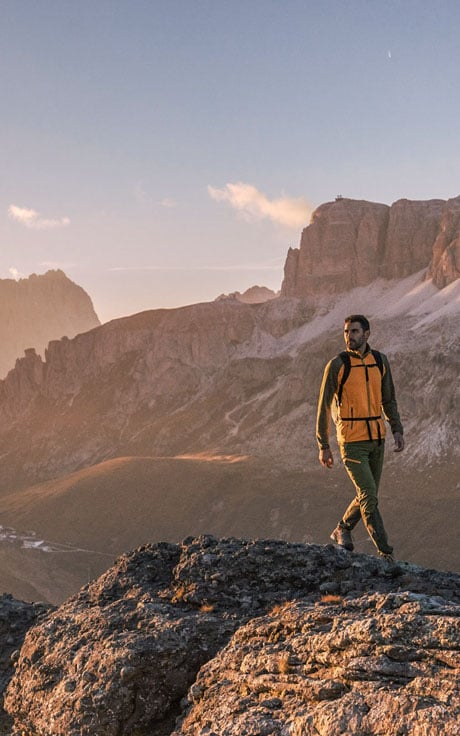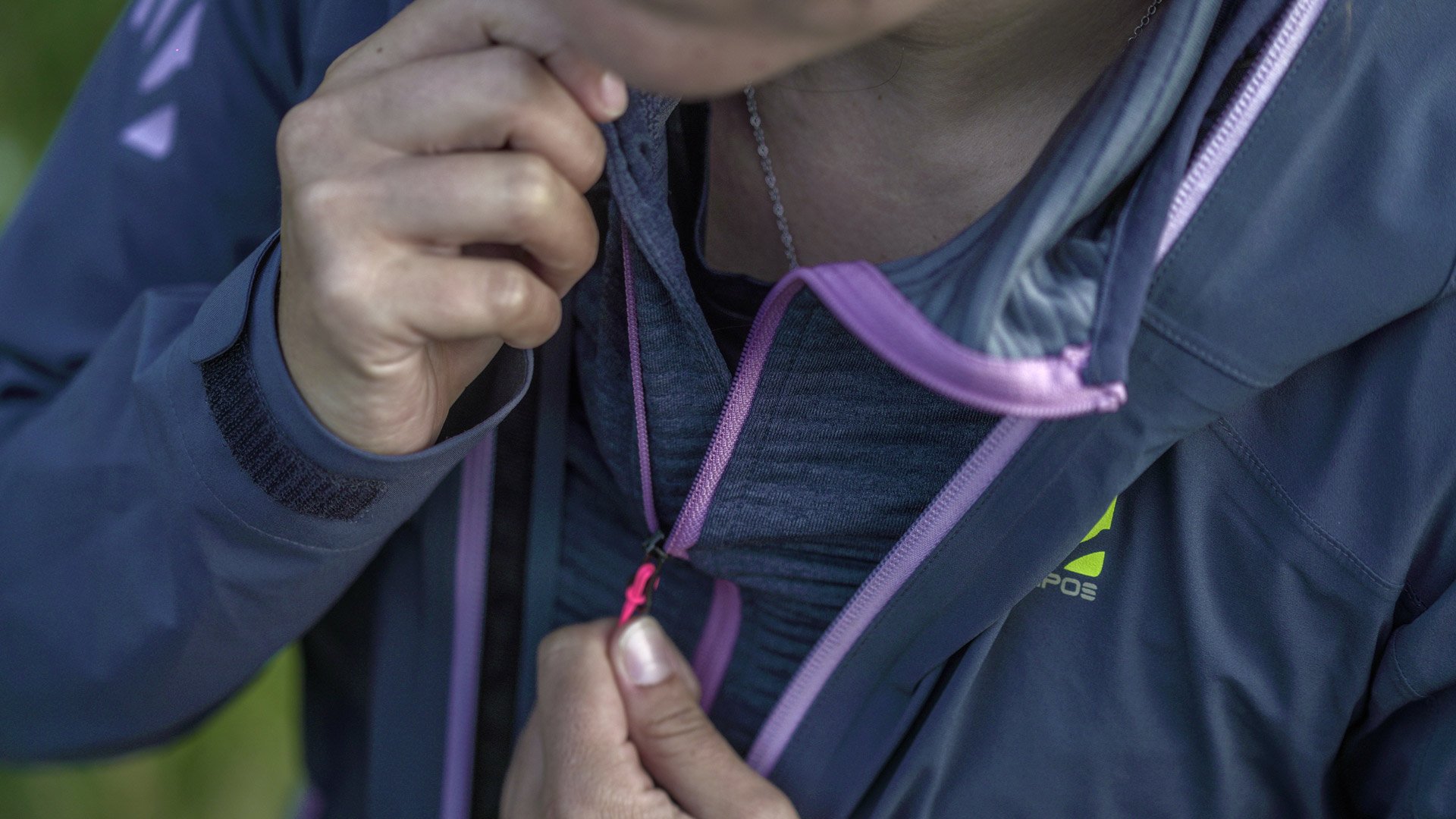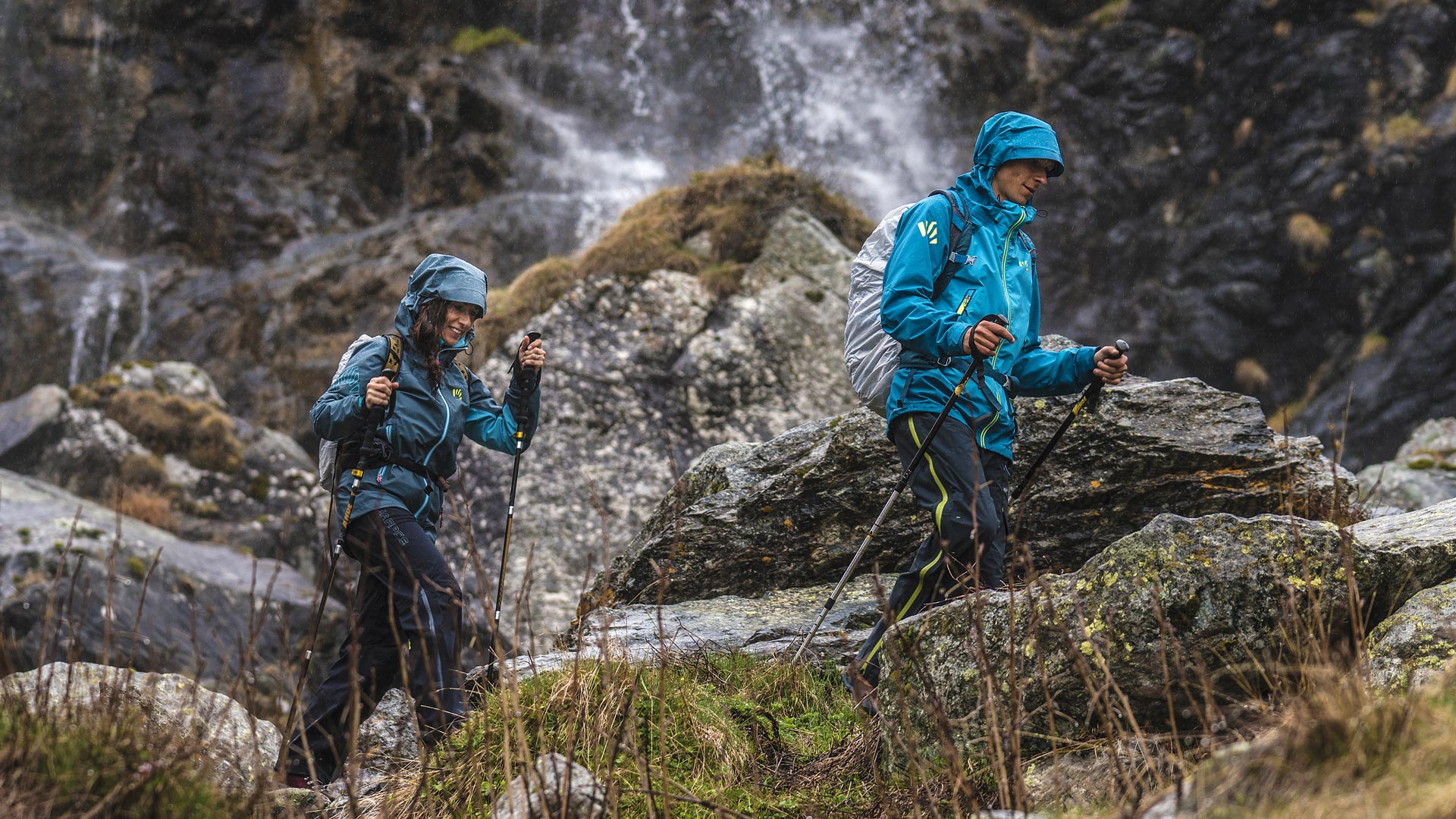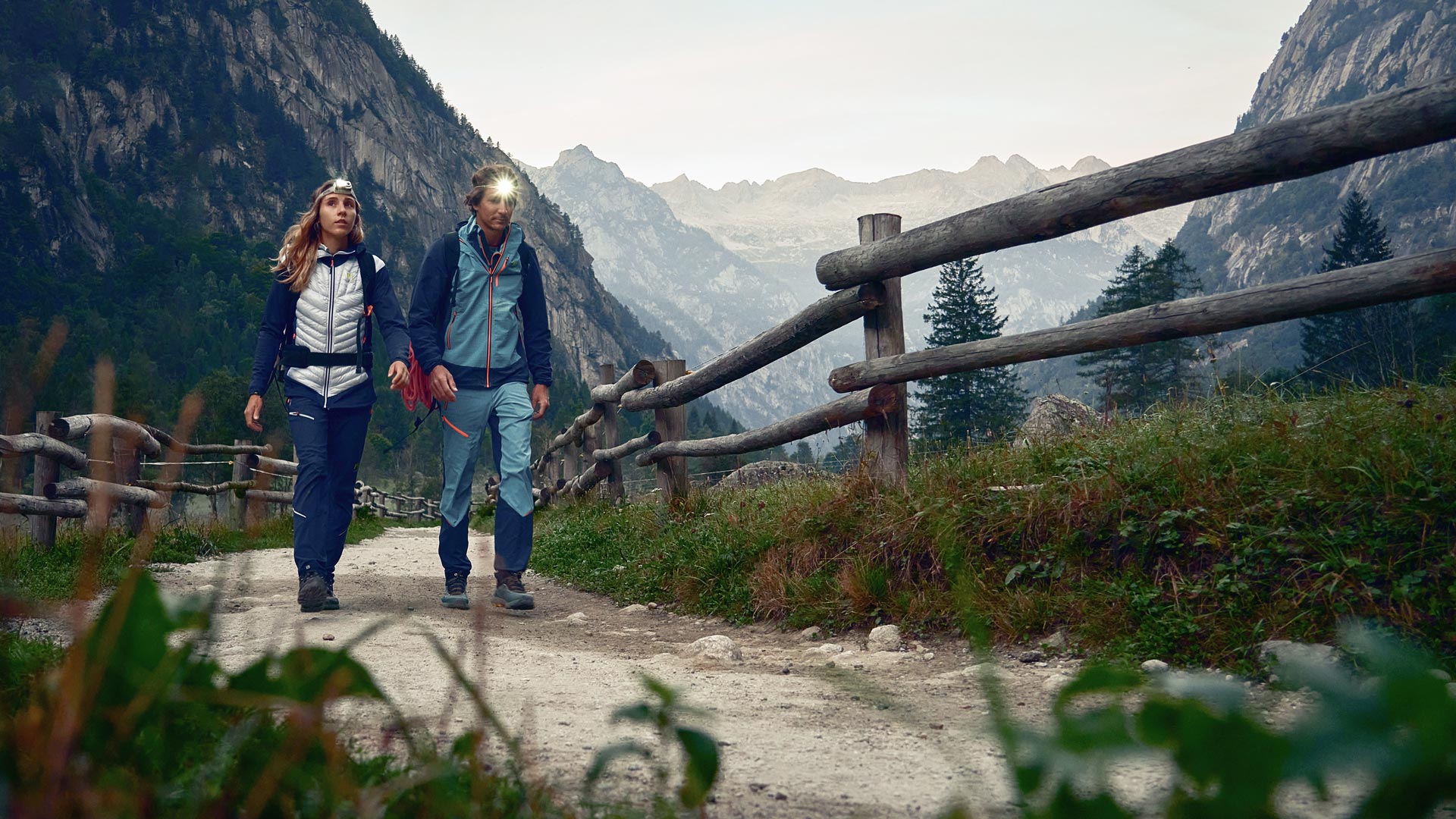
Getting started with hiking
Whatever the season, hiking is the simplest activity that an outdoor enthusiast can engage in. You don’t need any particular technical skills, and if you hike with expert friends or mountain professionals, you’ll soon be able to organize an enjoyable and rewarding outing on your own.
The first thing to remember is that this is an outdoor activity, so you need to choose routes that are suitable for your level of fitness and familiarity with the environment. At the beginning it’s good to start with easy outings; there will always be time later to seek out long traverses or challenging peaks.
But what’s the question that all hikers ask themselves when faced with having to organize an outing in the mountains? No, it’s not related to the physical effort, but rather to choosing the right hiking clothing. Is it necessary to dress in layers? How important is the choice of materials and different fabrics? And what if it rains?
Let’s find out the answers to these questions together through this guide that explains how to choose the right hiking clothing.
Contents
1. Dressing in layers: the real secret to hiking clothing
2. Why is hiking base layer so important?
2.1 What does a hiking base layer made of natural fibers offer?
2.2 Why choose a synthetic hiking base layer?
3. What kind of hiking T-shirt is best to wear?
4. What should the perfect hiking fleece be like?
4.1 Why choose a hiking fleece with hybrid construction?
5. When should you take a hiking down jacket with you?
5.1 Is a natural or synthetic hiking down jacket better?
6. The hiking shell: what is its function?
7. What are the key characteristics of hiking pants?
8. What hiking accessories are needed?
8.1 Hiking socks
8.2 Hiking headwear
8.3 Hiking gloves
9. So, what are the rules for choosing the right hiking clothing?
Dressing in layers: the real secret to hiking clothing

The secret to keep in mind when choosing hiking clothing? We’ve known it since we were children — our parents taught us: wear layers. A simple yet functional concept that allows you to quickly adapt to changing weather conditions, so you always stay dry and protected, whatever the conditions and whatever the intensity of your physical activity.
During high-intensity aerobic activity, you’ll most likely wear just a few layers and then be ready to put on a fleece or jacket as soon as you take a break or reach the pass or the summit. There are generally three key layers that make up the hiker’s outfit, which you need to consider when choosing the right clothing for hiking:
Base layer
In direct contact with the skin. Its function is to wick moisture away from the skin to keep you dry and support thermoregulation. It can be made of natural or synthetic materials — the important thing is that it be comfortable and perform its important thermal and insulation functions.
Intermediate layer
It has a thermal function, providing insulation from the cold and retaining heat. It must perform this function while remaining as lightweight and breathable as possible so as not to compromise perceived comfort. It can be made of either fleece or down; the solution chosen must be suitable for the type of excursion planned for that day, and for the expected weather conditions.
Outer layer
Its function is to protect you from atmospheric agents such as rain, wind, and snow. It consists of a jacket and pants called “shell” garments precisely because of the valuable function they perform. These garments are made with special membranes with specific qualities that make them simultaneously insulating, waterproof, and also breathable, to prevent too much moisture from accumulating underneath them.
Why is hiking base layer so important?
The function of the hiking base layer is to move moisture away from the body, allowing for the dispersion of excess heat and moisture during high-intensity physical activity. This allows you to avoid the unpleasant problems created by rapid cooling when you stop for a break or when the temperature drops.
The base layer is a critical layer — perhaps the most important when you’re choosing hiking clothing. The ideal base layer enables you to best deal with the different conditions you encounter out on the trail. Today there are garments available made of natural or synthetic materials, which have different characteristics.
In general, when choosing an hiking base layer, you need to remember a few simple rules: the garments should be close-fitting, comfortable, and breathable. They must not limit movement or compromise comfort, allowing our body to maintain proper thermoregulation without causing impediments.
What does a hiking base layer made of natural fibers offer?
In the winter, garments made with natural fibers, such as merino wool, are an excellent choice. Merino wool has many useful properties that enable it to insulate the body from cold as well as heat. But above all, it’s able to help conserve heat even in damp conditions and remain breathable, thus always supporting good thermoregulation.
In addition, wool is antibacterial, a characteristic that keeps the fabric from developing unpleasant odors — a valuable feature when you are tackling multiday hikes and don’t have the option of taking along too many changes of clothing, which would add unnecessary weight to your backpack.
Why choose a synthetic hiking base layer?
A synthetic base layer is lighter and dries more quickly, which makes it perfect for high-intensity activity. Developments in synthetic fibers have made it possible to produce extremely high-performance fabrics that deliver warmth and breathability and that represent a valid alternative to natural fibers.
What kind of hiking T-shirt is best to wear?
The T-shirt is often underestimated, but it plays a very important role when you’re choosing hiking clothing. You’ll want to leave the classic cotton T-shirt at home and instead choose a garment in technical and breathable fabric. Remember that it will be your best ally when you’re active in the mountains, so its importance should not be underestimated.
It must be comfortable and feel pleasant against the skin, ensure good breathability. New fabrics and new technologies have enabled the creation of synthetic garments that hinder the growth of bacteria — useful when you’re planning multiday excursions.
With technologies such as Polygiene® Odor Control, garments stay fresh for longer and can be washed less frequently, thus also increasing their durability. Appropriate fit is a factor that shouldn’t be underestimated for maximum comfort during a hike, so it’s best to find a happy medium between a loose fit and a tight fit.
For the hottest days, a good choice might be a T-shirt made with Polartec® Delta™, a special fabric that can retain some moisture, slowing the drying of the T-shirt and thus offering greater freshness, even during the highest-intensity activity.
What should the perfect hiking fleece be like?

Lightweight, compact, breathable, and protective. These are the key characteristics of a good hiking fleece. Its function is to serve as a second thermal layer, to help you conserve heat on the coldest winter days, or to put on in the early morning at the start of a summer excursion.
Today there are many different types available: with a zip, half-zip or without; with a hood or without; with more tightly woven fabric to offer a bit of protection from wind and atmospheric agents. Some are warmer than others, depending on the type of material they’re made with and their overall weight.
An hiking fleece needs to be chosen carefully, based on your needs. You’ll want more than one if you’re a frequent walker. The most convenient styles have a full zip, which allows you to regulate breathability by opening and closing the zipper, depending on how you feel at the moment.
Why choose a hiking fleece with hybrid construction?
Another important factor is the hybrid construction of the fleece. An hiking fleece will be more versatile if it’s constructed differently in the various areas of the body. A tightly woven and windproof fabric in the chest and shoulder area offers greater protection and warmth, while a more breathable fabric in the armpit and lower back areas helps to prevent overheating and excessive sweating.
When should you take a hiking down jacket with you?
Never forget your hiking down jacket. Whether it’s summer or winter, always remember to include a down jacket or a warm and protective jacket in your hiking wardrobe. Many different styles of jackets are available that are perfect for hiking — the important thing is that they be lightweight and compactible, so they don’t take up much space in your backpack.
In the summer, in direct sun, you’ll feel fine even with a simple T-shirt, but at dawn or dusk a warm thermal jacket will provide the right amount of warmth to allow you to enjoy one of the most beautiful sights in the mountains. You might also want a warm jacket on a cloudy day, so you can have peace of mind during every moment of the hike.
Is a natural or synthetic hiking down jacket better?
A jacket with synthetic insulation is ideal for wet days, with rain or snow. Synthetic down maintains its insulating properties even in damp conditions, unlike natural down, which loses much of its insulating power once it gets wet.
A valid solution to this problem is the new garments made with a DWR (durable water repellent) treatment applied to the goose down insulation. This allows the surface of the down to repel water and causes it to form droplets that slide away instead of being absorbed. The hiking down jacket thus retains its insulating capacity even in very wet conditions.
The hiking shell: what is its function?

It doesn’t take much to turn a pleasant walk into a nightmare. This is why it’s important not to forget to bring along a protective hiking shell that’s waterproof and packable. A garment that’s essential both to protect you in the event of a sudden change in the weather and to ensure protection from snow or wind.
Always remember to find a place in your backpack for your hiking shell, in a location that will allow you to access it quickly without having to dismantle half the backpack to look for it. You’ll need it when you reach a peak or a pass, to help maintain your body temperature when the wind puts you at risk of quickly becoming chilled. Likewise, it’s essential when you suddenly go from the heat of the sun to a violent downpour.
The protective hiking shell must not let water and humidity in, but at the same time it must be as breathable as possible, to allow excess moisture and heat to disperse. It achieves this through the use of the right fabrics in the areas most prone to sweating. In short, you must always feel dry and comfortable.
A good hiking shell must fit well and should have an adjustable hood, ideally with a rigid visor to ensure good visibility when the hood is up. Today, the best waterproof shells on the market can withstand a 20,000 mm water column while ensuring 10,000 g/m²/24 hours of breathability.
What are the key characteristics of hiking pants?
When you’re choosing hiking clothing, one of the most difficult pieces to select is the pants. In general, a good pair of hiking pants must respect a few basic rules. They must be protective and ensure ample freedom of movement.
Depending on the temperature and the season, you can choose between long hiking pants and shorts. A good middle-ground option is “zip-off” pants. They have zippers designed to allow you to convert them from long pants to shorts with a single movement, without having to take off your boots — the perfect solution to make sure you have both protection and, when needed, the ability to cool off.
Even in the heat, we would recommend long pants (for more protection from brambles, rocks, nettles, scree, snakes, sun, etc.) for multiday treks. Shorts, in contrast, are more suitable for day hikes in hot weather. But more specifically, what characteristics do hiking pants need to have?
Breathable
Hiking pants must be breathable and allow moisture and sweat to move away from the body. This is to keep you from getting chilled when you stop for a break, as well as to prevent irritation and other unpleasant and uncomfortable situations while you’re walking.
Quick drying
Hiking pants must also be quick drying, so that you can use them without concern even in the unfortunate event that they get soaked in a downpour. If the pants have a DRW treatment as well, even better. They’ll keep you dry even in difficult conditions.
Comfortable
The third — critical — characteristic of hiking pants is comfort. A good pair of hiking pants must have a comfortable fit, be lightweight, and not hinder movement. Thanks to the use of two-way stretch fabrics that are particularly comfortable against the skin, many pants today are able to ensure maximum freedom of movement and breathability.
Durable
Hiking pants must also be abrasion resistant; this can be enhanced through the use of special reinforcements in the areas most subject to rubbing. The use of two-way-stretch nylon fabrics, for example, allows for durable garments without sacrificing stretch and lightness.
But there’s no one perfect pair of hiking pants — on the contrary. There are garments designed for winter hiking and summer hiking, but also for spring and fall. There are more protective pants, designed for severe conditions, and others that are better suited to hot days and easier hikes.
What hiking accessories are needed?
The accessories that you need to consider when choosing clothing for hiking are few in number but still critical.
Hiking socks
If you spend hours in the store choosing the best shoes, the same should hold for socks, accessories that are too often underestimated and chosen hastily. A good pair of socks can make a big difference, helping to prevent annoying chafing with the consequent irritation and serious blisters.
These inflammations could potentially compromise the success of the excursion and be painful for days. So make sure you always wear the right kind of socks; reinforcements in key places, such as the heel and toe, and fabrics with a honeycomb texture, help to improve comfort and breathability throughout your hike.
Hiking headwear
A cap and a neck warmer are essential to protect your head from the cold. In the summer, a cap with a visor can protect your head from the sun’s rays, which should never be underestimated, especially at high elevations.
A neck warmer can be a versatile solution if you’re looking for one piece that can perform multiple functions. You can wear it to protect your neck from the wind, or close the drawstring to use it as a cap.
Hiking gloves
Finally, never forget a good pair of gloves, because the hands are often the part of the body that has the hardest time warming up. The more technical models are equipped, for example, with Clarino reinforcements on the back, palm, and fingertips, and a brushed lining — all features that make them useful to always carry with you.
So, what are the rules for choosing the right hiking clothing?

We’ve discussed how to choose the right hiking clothing, depending on the season and the many other variables that affect an excursion. Basically, your clothing must find the right balance between lightness, comfort, and protection — the perfect mix to allow you to experience a stress-free adventure in nature.
From the base layer that can wick away moisture from the skin and keep you dry, to thermal layers such as fleece and down for lower temperatures, to the hiking shell that is protective and breathable, every piece in the hiking outfit has a specific and essential role.
When selecting hiking clothing, give special attention to the pants, which should be chosen according to your need for protection and comfort. As well as socks and other hiking accessories useful for protecting also the most peripheral and most exposed areas of the body from the sun or cold.
The key is to enable dressing in layers. A first base layer, to wick moisture away from the skin; the second and third to protect from the cold; and the fourth waterproof and breathable, to protect from atmospheric agents. All complemented with the right accessories. Keep all this in mind and you won’t have any problems.
Now that you have everything you need, all you have to do is choose your next destination and set off. Happy hiking!